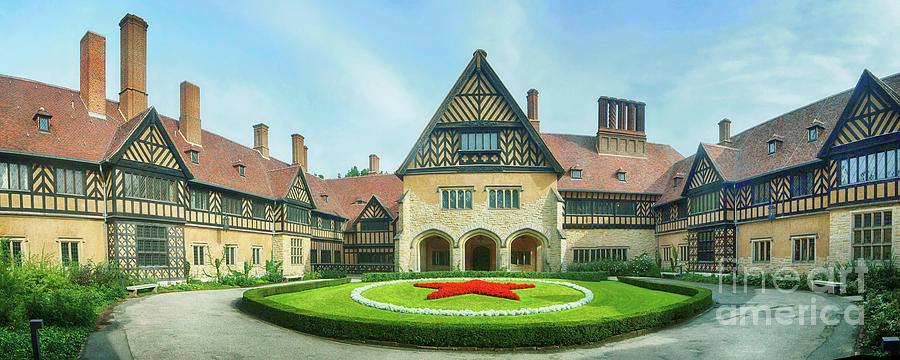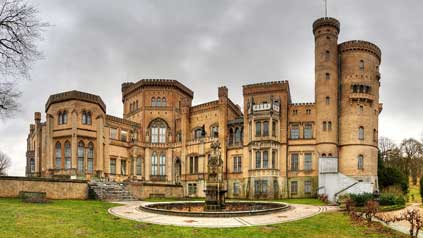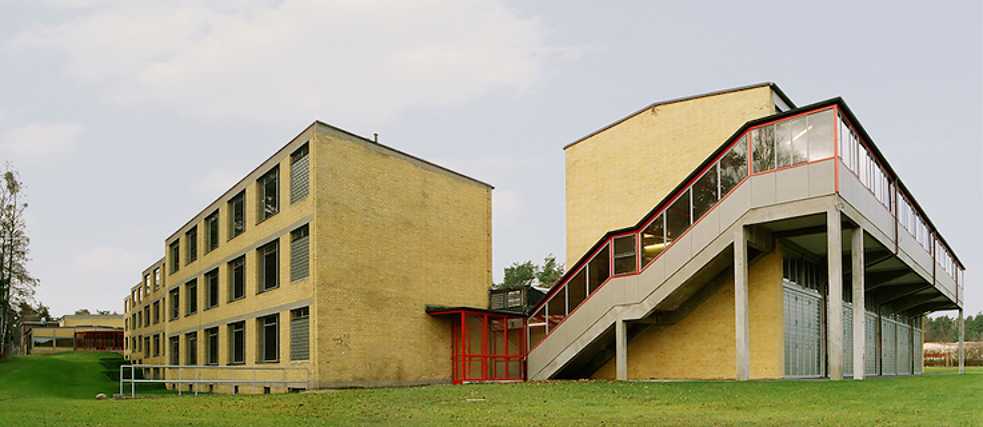Germany – Brandenburg (Potsdam, Cottbus) August 31, September 3, 2019
Caputh. In the NM “Villages and Small Towns” series, it got a railway station in 1904 and since became a remote residential area for wealthy urban people. Sights consist of Caputh Palace (1662, the hall has 7,500 pieces of delftware), Caputh Village Church (1852), Summer house of Albert Einstein (1929, a non swimmer, he was a passionate recreational sailor on the lake, used only until the Nazi takeover of 1933, now owned by Hebrew University in Jerusalem, only preserved residence of Einstein in Germany, museum with documents, photos and models
POTSDAM
Einstein Tower. In the NM “Modern Architecture Buildings”, this is a solar observatory built in 1921-24 to prove or disprove Einstein’s theory of relativity. Einstein never worked there but supported it. Light from the six telescopes is directed down to the basement where the laboratory is. Damaged in WW II, it was renovated in 1999. It is yellow, oval, 6-stories and has odd curved window arches and a curved entrance stairs. Einstein described it as “organic”. There is a bust of Einstein in the base of the tower. There is a tiny bronze brain cemented into the cobbles outside the tower. 
It is not open to the public except on some Saturdays in the winter by special arrangement (contact Urania Potsdam).
It is located in the gated Einstein Science Park, a research park (one of the tenants is Liebeniz-Institut für Astrophysics Potsdam) where there are also at least 3 other planetariums. Several of the buildings are modern but many are older attractive, yellow brick with red brick accents and decorative tiles. Park outside the gate and walk ~½km to the tower following the signs to Einsteinturm. The only sign in the park in English was the small notice on the front door of the Einstein Tower announcing the visitation possibilities.
Barberini Museum. The main art museum in Potsdam, it has 56 16th – 17th century Italian paintings (entitled “Baroque Pathways: the National Galleries Barberini Corsini in Rome”) including one Caravaggio. The Palazzo Barberini was the model for the Palace Barberini that Frederick the Great built in 1771-72 in Potsdam. Destroyed in the war, it was rebuilt as a modern museum in 2013-16.
There was also an exhibit on painters from the GDR. I especially enjoyed Gudrun Brune and Johannes Heisig. €14, no reduction
Film Museum. Showcases the world’s oldest film studio, Studio Babelsburg, that has been producing film since 1912-1945 (produced propaganda films for the Nazis). There are several cabinets with artist’s endowments, photos, set designs and the media history of Babelsburg. I did not find this so interesting as I knew none of the actors, directors or films. There is a cinema that shows films most days. It is housed in 18th century stables. €5, no reduction
FLUXUS+. Fluxis is an international art movement founded by George Maciunas (1931-78) that began around 1960 in New York, Tokyo and several European cities simultaneously first as a magazine and then concerts, festivals and contemporary art. The prime artist exhibited was Wolf Vostell (most I didn’t like but he had some interesting bronze sculpture juxtaposing odd elements with musical instruments. Note hours: Wed-Sun 1-6pm. €7.50, no reduction, but free when I was there as there was a one day festival happening in the park outside.
PALACES and PARKS of POTSDAM and BERLIN. These combine to make one World Heritage Site (1990). They represent a unity of landscape with monarchal ideas of the Prussian state and common efforts of emancipation spanning the years 1730-1916. Initially there were 150 buildings, several were destroyed by the Berlin Wall death strip fortifications but was extended in 1992 and 1999.
1990: Palace and Park of Sanssouci, Potsdam; New Garden, Marble Pavilion and Schloss Cecilienhof, Potsdam; Park Bebelsberg and Schloss Bebelsberg, Potsdam; Schloss Gliencke and Park Klein-Glienicke, Berlin; Peacock Island, Berlin; Mount Bottcher, Berlin; Glienicke hunting lodge, Berlin.
1992 extension: Church of the Redeemer, Potsdam; Palace and Park of Sacrow, Potsdam.
1999 extension: Lindenallen, Potsdam; Königliche Gärtnerlehhranstalt and the Kaiserbahnhof, Potsdam; Village of Bornstedt, church, cemetery, and landscape north of Park Sanssouci and New Garden, Potsdam; Entrance area of Park Sanssouci, Potsdam; Alexandrowka log houses, Potsdam; Phingstberg and Belvedere auf dem Pfingstberg, Potsdam; Southern shore of Jungfernsee, Potsdam; Königswald (King’s Forest, forests surrounding Palace and Park of Sacrow, Potsdam; Approaches to Babelsberg Park, Potsdam; Observatory in Babelsberg, Potsdam.
SANSSOUCI PARK
Sanssouci Palace. The summer home of Frederick the Great, King of Prussia was built from 1745-47. It is little more than a large, single story villa with only 10 principle rooms. It was neglected until 1840, it was the residence of Frederick IV who changed it into a fashionable country house and added modern (for 19th century) kitchens and service rooms. Fronted by a double colonnade, it is Rococo in style (Baroque with grace and lightness), a single story block with 2 service wings.
After WW II it became a tourist attraction and Frederick’s body was returned to a new tomb in 1990. €12, no reduction
Historic Mill at Sanssouci Park. First built in 1738, it was severely damaged and rebuilt in 1858. With a stone base, a Dutch cap, the top is shaked above the large balcony. Rarely, this mill still operates and produces its own flour and seminola. The vanes were turning when I was there, the inside gears all turning but the grindstone was not engaged. €4
Potsdam Botanical Gardens. On both sides of the road, the south side is centered around 10 connected greenhouses (€2). Great cacti and ferns but rest not so interesting. The large mature forest of the park surrounds the gardens. Free
New Palace. Built by King Frederick III from 1763-1969, to celebrate the victory in the Seven Years War, it is considered the last great Prussian Baroque palace. It was not his residence but a display for visiting royals and dignitaries with over 200 rooms, 4 gathering rooms and a theatre. An enormous dome was built over the center and 400 statues added. The interior is over the top with ornate marble floors, painted and gilt ceilings, cut crystal chandeliers, statues, and enormous paintings.
After his death in 1786, it fell into disuse until 1859 when Frederick III used it as a summer residence and then for the 99 days of his reign. His son William II renovated it with steam heating and electricity and used it as his principal residence until 1918 when he abdicated and went into exile in the Netherlands. He also moved the furnishings and they were discovered in their original packing cases in 1970 and returned to Germany. The palace escaped damage in WW Ii so now looks much as it did in 1918.
On the west edge of Sanssouci Park, the palace is fronted by a huge semicircular collanade four columns deep connected to newly reconstructed wings with great double curving stairs that served as service buildings with kitchens, shops, guards and servants. They are now occupied by the University of Potsdam.
Cecilienhof Palace. Built in 1917, the home of Crown Prince Wilhelm. it is a 2-story half-timbered construction on a stone base. This is where the July 17 – August 2, 1945 Potsdam Conference was held when Churchill, Stalin and Truman determined how to administer Germany that had agreed to unconditional surrender nine weeks earlier on May 8. €8

POTSDAM CONFERENCE
Decisions:
Germany and Austria were to be divided into 4 occupation zones each, as were Berlin and Vienna.
Nazi war criminals would be put on trial.
All German annexations were to be reversed including Sudetenland, Alsace-Lorraine, Austria and western Poland.
Germany’s eastern border was to be shifted westward to the Oder-Neisse line reducing Germany in size by about 25% from its 1937 borders. The territories east were East Prussia, Silesia, West Prussia and ⅔ of Pomerania – mainly agricultural except Upper Silesia, the 2nd largest centre of German industry.
Expulsion of German populations beyond that border from Poland, Czechoslovakia and Hungary but not Yugoslavia.
War reparations to the Soviet Union including 10% of the industrial capacity unnecessary for the German peace economy.
German standards of living would not exceed the European average.
German industrial war potential was to be destroyed (all civilian shipyards and aircraft factories, metals, chemical and machinery were to be reduced to a minimum). All research and international trade was to be controlled. Germany was to be converted into an agricultural and light industrial economy (exports were to be coal, beer, toys and textiles).
Babelsberg Palace. Built in 1835-49, or 50 years it was the summer residence of Prince William later William I. In Babelsberg Park on the far side of Lake Wannsee, this looks like a new building but with the trimmings of a castle – crenellated towers, roof lines and false turrets. It is open to the public only for special exhibits. 
GO TO Germany – Berlin August 31-Sept 2, 2019
ADGB Trade Union School, Bernau bei Berlin. In the NM “Modern Architecture Buildings” series. this building is NE of Berlin and one of the early Barhaus designed buildings.

From Berlin, I decided to take a long loop through the east of Germany along the Polish border to see many XL series sites in both Germany and ones in Poland that I had missed as they were so out of the way. Most are twin cities on either side of the border formed by the Oder-Neisse Line that became the border in 1945 – the River Oder and the River Neisse. I ended up crossing the river 5 times.
The big businesses in Poland are selling cigarettes, half the price in Germany, hairdressers and cheaper gas.
Küstriner Vorland, Germany (pop 2,600) / Kostryn nad Odra, Poland (pop 20,000. Burned down by Napoleon’s troops in 1806 and 95% destroyed in WW II. Przystanek Woodstock festival is the largest open-air music festival in Europe)
Frankfurt an der Oder, Germany (pop 58,000. Burned down in 1945, high unemployment and low growth since 1990) / Slubice, Poland (pop 18,000.
Wikipedia Monument. In a small square in Slubice, it shows four nude figures holding aloft a globe based on the Wikipedia logo. It was erected in 2014 to highlight the town’s importance as an academic centre – Polish Wikipedia is the 12th largest Wikipedia.
Guben, Germany (pop 20,000. Since 16th century economy based on textiles – leather gloves, hats, rugs, shoes. Now has factory producing plastic cadavers) /Gubin, Poland
Forst, Germany (pop 18,000. Extreme unemployment since 1990) / Zasieki, Poland (pop 300)
Bad Muskau, Germany (pop 3,700. Bad refers to the spa built here) / Leknica, Poland (pop 2,600. In WW II, 70% of city destroyed including the brown coal mine, glass works and slate factory)
Muskau Park. This is the largest and most famous English garden in Central Europe, stretching along both sides of the Neisse River and connected by the English pedestrian bridge. Built in 1815 by Prince Hermann von Puckler-Muskau (1785-1871) and centered on his residence, Schloss Muskau (a medieval castle reconstructed. Completely destroyed in WW II and Old Castle rebuilt by the Polish government from 1965-72, the New Castle is still being reconstructed). The park is 3.5km2, with 1.4km2 in Poland and 2.1km2 in Germany. The heart of the park is on the park terraces on the east side.
In 2004, became a WHS based on its ideal man-made landscape and for its influence on the development of landscape architecture as a discipline.
GO TO Germany – Saxony (Dresden, Leipzig, Chemnitz)
NOMAD MANIA GERMANY – Brandenburg (Potsdam, Cottbus)
World Heritage Sites
Palaces and Parks of Potsdam and Berlin
Primeval Beech Forests of the Carpathians and the Ancient Beech Forests of Germany
Sights
Glienicke Bridge
Borders: Germany-Poland
XL
Forst (Lausitz)/Zasieki
Frankfurt an der Oder/Slubice
Guben/Gubin
Küstrin/Kostryn nad Odra
Airports: Berlin – Schönefeld (SXF)
Railway, Metro, Funiculars, Cable Cars
Frankfurt an der Oder Trams
Strausberg Railway
Modern Architecture Buildings: Bernau bei Berlin: ADGB Trade Union School World of Nature: Lower Oder Valley
Entertainment/Things to do: Go Paintball Adventure Park, Garzau-Garzin
Windmills
Angermünde: Greiffenberger Mühle
Straupitz: Windmühle Straupitz
The Dark Side: Wünsdorf (former Soviet town in East Germany)
European Cities
COTTBUS
Railway, Metro, Funiculars, Cable Cars: Cottbus Trams
Museums: Kunstmuseum Diesel Power Station
POTSDAM
World Heritage Sites: Palaces and Parks of Potsdam and Berlin
Railway, Metro, Funiculars, Cable Cars: Potsdam Trams
Museums
Barberini Museum
Film Museum
FLUXUS+
Castles, Palaces, Forts
Babelsberg Palace
Cecilienhof Palace
New Palace
Sanssouci Palace
Modern Architecture Buildings: Einstein Tower
Botanical Gardens: Potsdam Botanical Gardens
Windmills: Historic Mill at Sanssouci Park
Villages and Small Towns
Caputh
